当前位置:
X-MOL 学术
›
J. Membr. Sci.
›
论文详情
Our official English website, www.x-mol.net, welcomes your
feedback! (Note: you will need to create a separate account there.)
Carboxylic polyethersulfone: A novel pH-responsive modifier in support layer of forward osmosis membrane
Journal of Membrane Science ( IF 8.4 ) Pub Date : 2018-02-01 , DOI: 10.1016/j.memsci.2017.10.044 Hasan Salehi , Alireza Shakeri , Masoud Rastgar
Journal of Membrane Science ( IF 8.4 ) Pub Date : 2018-02-01 , DOI: 10.1016/j.memsci.2017.10.044 Hasan Salehi , Alireza Shakeri , Masoud Rastgar

|
Abstract Carboxylic polyethersulfone (CPES) was synthesized through a facile acetylation reaction followed by an oxidation treatment and used as a modifier in support layer composition of forward osmosis (FO) membrane. The hydrophilic CPES polymer could ameliorate thin film composite (TFC) membrane performance in water permeation. The inferior sponge-like structure of the pristine PES substrate was changed to appropriate long finger-like one, when the CPES modified polymer dope solution was casted in a basic coagulation bath. In such operational condition, attached carboxylic functional groups were almost deprotonated and the electrostatic repulsion forces among them resulted in the formation of a substrate with open pores and less dense morphology. To prove pH-responsive characteristics of the CPES blended membranes, pH of coagulation bath was switched from 3 to 12. By doing so, water flux drastically increased from 14.23 to 28.03 LMH and from 27.80 to 46.17 LMH in FO mode (active layer facing feed water) and PRO mode (active layer facing draw solution), respectively. Further studies showed that such pH treatments could also lower the unfavorable structure parameter (S) from 1423.54 to 653.94 µm. The pH-reversibility of the obtained membranes were evaluated using different draw solution pH values. In an acidic draw solution (pH = 3), the protonated carboxylic functional groups started shrinking and thus could open the substrate’s pores, which facilitate rapid water transportation. This investigation may open up a new class of pH-responsive and pH-reversible material for promising FO process, in which permeability and selectivity of a FO membrane could be readily controlled through fluctuation in pH of coagulation bath or draw solution.
中文翻译:

羧基聚醚砜:一种新型的正渗透膜支撑层pH响应改性剂
摘要 羧基聚醚砜 (CPES) 通过简单的乙酰化反应和氧化处理合成,用作正渗透 (FO) 膜支撑层组合物中的改性剂。亲水性CPES聚合物可以改善薄膜复合(TFC)膜的透水性能。当 CPES 改性聚合物涂料溶液在碱性凝固浴中浇铸时,原始 PES 基材的劣质海绵状结构变为适当的长指状结构。在这种操作条件下,附着的羧基官能团几乎被去质子化,它们之间的静电排斥力导致形成具有开孔和较不致密形态的基材。为了证明 CPES 混合膜的 pH 响应特性,凝固浴的 pH 值从 3 切换到 12。通过这样做,在 FO 模式(活性层面向给水)和 PRO 模式(活性层面向驱动溶液)下,水通量从 14.23 LMH 急剧增加到 28.03 LMH,从 27.80 LMH 急剧增加到 46.17 LMH , 分别。进一步的研究表明,这种 pH 处理还可以将不利的结构参数 (S) 从 1423.54 降低到 653.94 µm。使用不同的汲取溶液 pH 值评估所得膜的 pH 可逆性。在酸性绘图溶液(pH = 3)中,质子化的羧基官能团开始收缩,从而可以打开基材的孔,从而促进水的快速传输。这项研究可能为有前途的 FO 工艺开辟一类新的 pH 响应和 pH 可逆材料,
更新日期:2018-02-01
中文翻译:

羧基聚醚砜:一种新型的正渗透膜支撑层pH响应改性剂
摘要 羧基聚醚砜 (CPES) 通过简单的乙酰化反应和氧化处理合成,用作正渗透 (FO) 膜支撑层组合物中的改性剂。亲水性CPES聚合物可以改善薄膜复合(TFC)膜的透水性能。当 CPES 改性聚合物涂料溶液在碱性凝固浴中浇铸时,原始 PES 基材的劣质海绵状结构变为适当的长指状结构。在这种操作条件下,附着的羧基官能团几乎被去质子化,它们之间的静电排斥力导致形成具有开孔和较不致密形态的基材。为了证明 CPES 混合膜的 pH 响应特性,凝固浴的 pH 值从 3 切换到 12。通过这样做,在 FO 模式(活性层面向给水)和 PRO 模式(活性层面向驱动溶液)下,水通量从 14.23 LMH 急剧增加到 28.03 LMH,从 27.80 LMH 急剧增加到 46.17 LMH , 分别。进一步的研究表明,这种 pH 处理还可以将不利的结构参数 (S) 从 1423.54 降低到 653.94 µm。使用不同的汲取溶液 pH 值评估所得膜的 pH 可逆性。在酸性绘图溶液(pH = 3)中,质子化的羧基官能团开始收缩,从而可以打开基材的孔,从而促进水的快速传输。这项研究可能为有前途的 FO 工艺开辟一类新的 pH 响应和 pH 可逆材料,











































 京公网安备 11010802027423号
京公网安备 11010802027423号